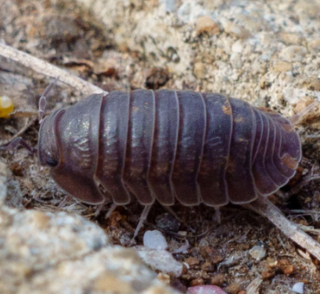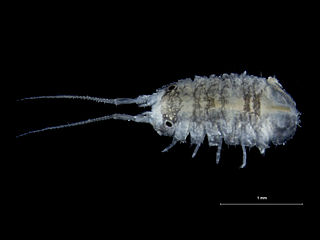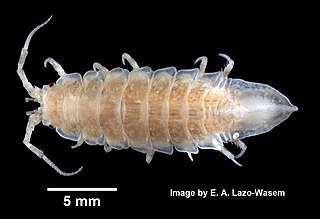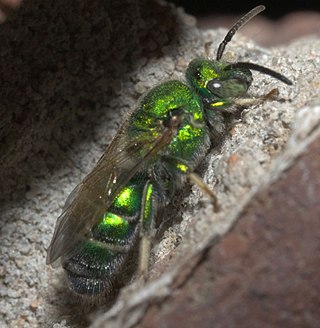
Isopoda is an order of crustacean, which includes woodlice and their relatives. Members of this group are called Isopods and include both terrestrial and aquatic species. All have rigid, segmented exoskeletons, two pairs of antennae, seven pairs of jointed limbs on the thorax, and five pairs of branching appendages on the abdomen that are used in respiration. Females brood their young in a pouch under their thorax.

Armadillidium vulgare, the common pill-bug, potato bug, common pill woodlouse, roly-poly, slater, doodle bug, or carpenter, is a widespread European species of woodlouse. It is the most extensively investigated terrestrial isopod species.

Cymothoa exigua, or the tongue-eating louse, is a parasitic isopod of the family Cymothoidae. It enters fish through the gills. The female attaches to the tongue, while the male attaches to the gill arches beneath and behind the female. Females are 8–29 mm (0.3–1.1 in) long and 4–14 mm (0.16–0.55 in) wide. Males are about 7.5–15 mm (0.3–0.6 in) long and 3–7 mm (0.12–0.28 in) wide. The parasite severs the blood vessels in the fish's tongue, causing the tongue to fall off. It then attaches itself to the remaining stub of tongue and the parasite itself effectively serves as the fish's new "tongue".

Poecilotheria metallica, also known as the peacock tarantula, is an Old World species of tarantula. It is the only blue species of the genus Poecilotheria. Like others in its genus it exhibits an intricate fractal-like pattern on the abdomen. The species' natural habitat is deciduous forest in Andhra Pradesh, in central southern India. It has been classified as Critically endangered by the IUCN.

Pentidotea wosnesenskii is a marine isopod which lives on seaweed on rocky shores along the British Columbia and Washington coastlines, as far south as San Francisco. It can often be found hiding under rockweed in the intertidal zone, and can be found in depths up to 919 metres (3,015 ft). It was described as Idotea wosnesenskii in 1851, by Johann Friedrich von Brandt, and is named after the Russian biologist Ilya G. Voznesensky. The isopod grows up to 4 centimetres in length and is usually green in colour.

Idotea is a genus of isopod crustaceans, mostly from cold temperate waters. The taxonomy of the genus is still in doubt, and many of the currently recognised species may be taxonomic synonyms, and others may be moved to different genera.

The Idoteidae are a family of isopod crustaceans. It includes these genera:

Idotea balthica is a species of marine isopod which lives on seaweed and seagrass in the subtidal zone of rocky shores and sandy lagoons.
Idotea linearis is a species of elongated isopod crustacean.

Idotea granulosa is a species of marine isopod in the family Idoteidae.

Cubaris is a genus of woodlice in the family Armadillidae. There are more than 100 described species in the Cubaris genus.

Pentidotea resecata, the eelgrass isopod, is a species of isopod in the family Idoteidae. It is found in North America.

Pentidotea is a genus of isopods in the family Idoteidae. There are about 13 described species in Pentidotea.
Plateumaris metallica is a species of aquatic leaf beetle in the family Chrysomelidae. It is found in North America.

Jaera albifrons is a species of isopod in the family Janiridae. It is found in Europe and North America.

Idotea phosphorea is a species of isopod in the family Idoteidae. It is found in North America.

Augochloropsis is a genus of brilliant metallic, often blue-green, sweat bees in the family Halictidae. There are at least 140 described species in Augochloropsis.

Haplophthalmus danicus, also known as the terrestrial cave isopod or spurred ridgeback isopod, is a species of woodlouse in the family Trichoniscidae. It is naturally found in Europe, Southern Asia, and temperate Asia, however it has been introduced to North America. This species was likely introduced during original European settlement, and therefore has been well established in terrestrial communities.

Augochloropsis metallica is a species of sweat bee in the family Halictidae.
Idotea neglecta is a marine isopod in the family Idoteidae. It can be found on algae in the littoral and sublittoral zone of north-west European coasts.
















